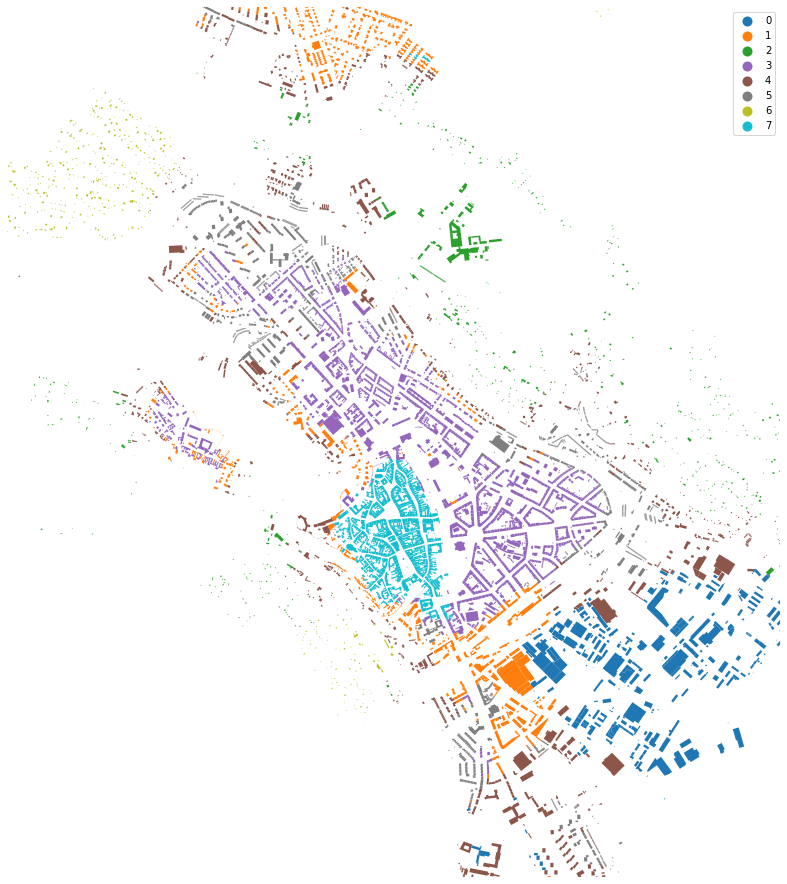Note
Simplified detection of urban types#
Example adapted from the SDSC 2021 Workshop led by Martin Fleischmann. You can see the recording of the workshop on YouTube.
This example illustrates the potential of morphometrics captured by momepy in capturing the structure of cities. We will pick a town, fetch its data from the OpenStreetMap, and analyse it to detect individual types of urban structure within it.
This method is only illustrative and is based on the more extensive one published by Fleischmann et al. (2021) available from martinfleis/numerical-taxonomy-paper.
Fleischmann M, Feliciotti A, Romice O and Porta S (2021) Methodological Foundation of a Numerical Taxonomy of Urban Form. Environment and Planning B: Urban Analytics and City Science, doi: 10.1177/23998083211059835
It depends on the following packages:
- momepy
- osmnx
- clustergram
- bokeh
- scikit-learn
- geopy
- ipywidgets
[1]:
import warnings
import geopandas
import libpysal
import momepy
import osmnx
import pandas
from clustergram import Clustergram
import matplotlib.pyplot as plt
from bokeh.io import output_notebook
from bokeh.plotting import show
output_notebook()
Pick a place, ideally a town with a good coverage in OpenStreetMap and its local CRS.
[2]:
place = 'Znojmo, Czechia'
local_crs = 5514
We can interactively explore the place we just selected.
[3]:
geopandas.tools.geocode(place).explore()
[3]:
Input data#
We can use OSMnx to quickly download data from OpenStreetMap. If you intend to download larger areas, we recommend using pyrosm instead.
Buildings#
[4]:
buildings = osmnx.geometries.geometries_from_place(place, tags={'building':True})
buildings.head()
[4]:
| amenity | geometry | tourism | brand | brand:wikidata | brand:wikipedia | name | operator | operator:wikidata | operator:wikipedia | ... | voltage | source_1 | pillbox | name:signed | building:part | ref | min_height | ways | type | emergency | ||
|---|---|---|---|---|---|---|---|---|---|---|---|---|---|---|---|---|---|---|---|---|---|---|
| element_type | osmid | |||||||||||||||||||||
| node | 3749294087 | place_of_worship | POINT (16.04696 48.85305) | NaN | NaN | NaN | NaN | NaN | NaN | NaN | NaN | ... | NaN | NaN | NaN | NaN | NaN | NaN | NaN | NaN | NaN | NaN |
| 4756492121 | place_of_worship | POINT (16.02817 48.83953) | NaN | NaN | NaN | NaN | NaN | NaN | NaN | NaN | ... | NaN | NaN | NaN | NaN | NaN | NaN | NaN | NaN | NaN | NaN | |
| 6898265457 | NaN | POINT (16.01186 48.85677) | NaN | NaN | NaN | NaN | NaN | NaN | NaN | NaN | ... | NaN | NaN | NaN | NaN | NaN | NaN | NaN | NaN | NaN | NaN | |
| way | 50293678 | place_of_worship | POLYGON ((16.03814 48.85812, 16.03814 48.85814... | NaN | NaN | NaN | NaN | sv. Antonín | NaN | NaN | NaN | ... | NaN | NaN | NaN | NaN | NaN | NaN | NaN | NaN | NaN | NaN |
| 50293682 | place_of_worship | POLYGON ((16.03830 48.85657, 16.03833 48.85659... | NaN | NaN | NaN | NaN | Eliášova kaple | NaN | NaN | NaN | ... | NaN | NaN | NaN | NaN | NaN | NaN | NaN | NaN | NaN | NaN |
5 rows × 91 columns
The OSM input may need a bit of cleaning to ensure only proper polygons are kept.
[5]:
buildings.geom_type.value_counts()
[5]:
Polygon 12127
Point 3
dtype: int64
[6]:
buildings = buildings[buildings.geom_type == "Polygon"].reset_index(drop=True)
And we should re-project the data from WGS84 to the local projection in meters (momepy default values assume meters not feet or degrees). We will also drop unnecessary columns.
[7]:
buildings = buildings[["geometry"]].to_crs(local_crs)
Finally, we can assign unique ID to each row.
[8]:
buildings["uID"] = range(len(buildings))
buildings.head()
[8]:
| geometry | uID | |
|---|---|---|
| 0 | POLYGON ((-643743.474 -1193358.749, -643743.30... | 0 |
| 1 | POLYGON ((-643751.446 -1193530.633, -643749.37... | 1 |
| 2 | POLYGON ((-643281.601 -1193130.831, -643283.76... | 2 |
| 3 | POLYGON ((-643381.904 -1193174.697, -643388.48... | 3 |
| 4 | POLYGON ((-643370.450 -1193130.215, -643398.26... | 4 |
Streets#
Similar operations are done with streets.
[9]:
osm_graph = osmnx.graph_from_place(place, network_type='drive')
osm_graph = osmnx.projection.project_graph(osm_graph, to_crs=local_crs)
streets = osmnx.graph_to_gdfs(
osm_graph,
nodes=False,
edges=True,
node_geometry=False,
fill_edge_geometry=True
)
[10]:
streets.head()
[10]:
| osmid | ref | name | highway | oneway | length | geometry | maxspeed | lanes | bridge | junction | width | tunnel | access | |||
|---|---|---|---|---|---|---|---|---|---|---|---|---|---|---|---|---|
| u | v | key | ||||||||||||||
| 74103628 | 639231391 | 0 | 33733060 | 361 | Přímětická | secondary | False | 24.574 | LINESTRING (-643239.057 -1192850.232, -643229.... | NaN | NaN | NaN | NaN | NaN | NaN | NaN |
| 3775990798 | 0 | 33733060 | 361 | Přímětická | secondary | False | 60.354 | LINESTRING (-643239.057 -1192850.232, -643241.... | NaN | NaN | NaN | NaN | NaN | NaN | NaN | |
| 639231391 | 74103628 | 0 | 33733060 | 361 | Přímětická | secondary | False | 24.574 | LINESTRING (-643229.639 -1192872.949, -643239.... | NaN | NaN | NaN | NaN | NaN | NaN | NaN |
| 74142638 | 0 | 33733060 | 361 | Přímětická | secondary | False | 54.260 | LINESTRING (-643229.639 -1192872.949, -643219.... | NaN | NaN | NaN | NaN | NaN | NaN | NaN | |
| 639231314 | 0 | 50313241 | NaN | Mičurinova | residential | True | 101.376 | LINESTRING (-643229.639 -1192872.949, -643233.... | NaN | NaN | NaN | NaN | NaN | NaN | NaN |
We can also do some preprocessing using momepy to ensure we have proper network topology.
[11]:
streets = momepy.remove_false_nodes(streets)
streets = streets[["geometry"]]
streets["nID"] = range(len(streets))
[12]:
streets.head()
[12]:
| geometry | nID | |
|---|---|---|
| 0 | LINESTRING (-643239.057 -1192850.232, -643229.... | 0 |
| 1 | LINESTRING (-643239.057 -1192850.232, -643241.... | 1 |
| 2 | LINESTRING (-643229.639 -1192872.949, -643239.... | 2 |
| 3 | LINESTRING (-643229.639 -1192872.949, -643219.... | 3 |
| 4 | LINESTRING (-643229.639 -1192872.949, -643233.... | 4 |
Generated data#
Tessellation#
Given building footprints:
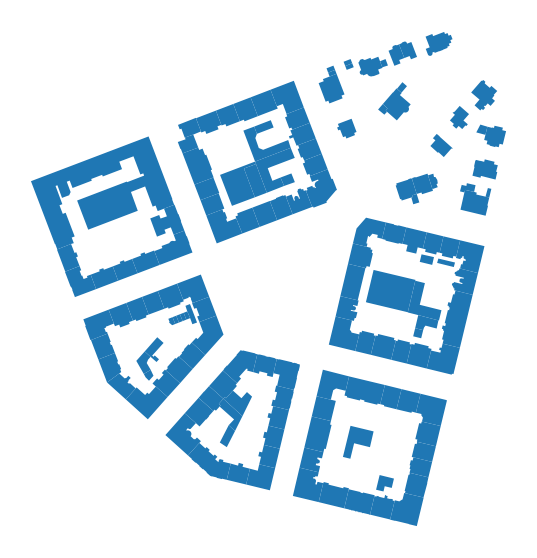
We can generate a spatial unit using morphological tessellation:
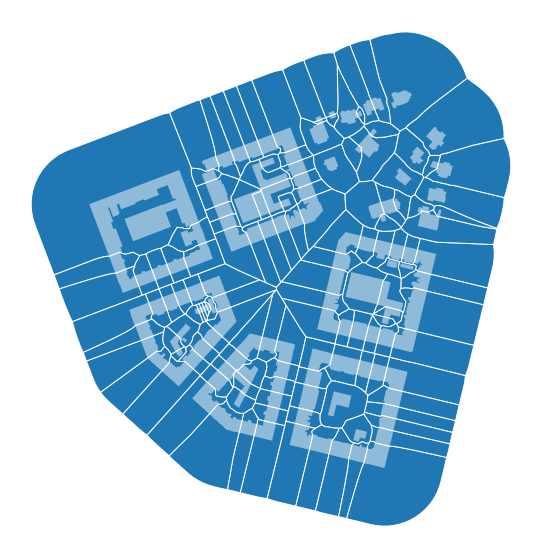
[13]:
limit = momepy.buffered_limit(buildings, 100)
tessellation = momepy.Tessellation(buildings, "uID", limit, verbose=False, segment=1)
tessellation = tessellation.tessellation
/Users/martin/mambaforge/envs/stable/lib/python3.9/site-packages/momepy/elements.py:383: UserWarning: Tessellation does not fully match buildings. 23 element(s) collapsed during generation - unique_id: {11652, 11653, 10630, 11660, 4237, 4245, 4248, 3999, 11431, 11432, 4009, 4275, 4278, 4282, 4283, 4287, 4288, 9177, 10851, 10852, 8682, 4089, 9212}
warnings.warn(
/Users/martin/mambaforge/envs/stable/lib/python3.9/site-packages/momepy/elements.py:394: UserWarning: Tessellation contains MultiPolygon elements. Initial objects should be edited. unique_id of affected elements: [10034, 9864, 4227, 3263, 3196, 11965, 3209, 11168]
warnings.warn(
Link streets#
Link unique IDs of streets to buildings and tessellation cells based on the nearest neighbor join.
[14]:
buildings = buildings.sjoin_nearest(streets, max_distance=1000, how="left")
buildings.head()
[14]:
| geometry | uID | index_right | nID | |
|---|---|---|---|---|
| 0 | POLYGON ((-643743.474 -1193358.749, -643743.30... | 0 | 1048.0 | 1048.0 |
| 0 | POLYGON ((-643743.474 -1193358.749, -643743.30... | 0 | 1047.0 | 1047.0 |
| 1 | POLYGON ((-643751.446 -1193530.633, -643749.37... | 1 | 1457.0 | 1457.0 |
| 2 | POLYGON ((-643281.601 -1193130.831, -643283.76... | 2 | 243.0 | 243.0 |
| 2 | POLYGON ((-643281.601 -1193130.831, -643283.76... | 2 | 886.0 | 886.0 |
Clean duplicates and attach the network ID to the tessellation as well.
[15]:
buildings = buildings.drop_duplicates("uID").drop(columns="index_right")
tessellation = tessellation.merge(buildings[['uID', 'nID']], on='uID', how='left')
Measure#
Measure individual morphometric characters. For details see the User Guide and the API reference.
Dimensions#
[16]:
buildings["area"] = buildings.area
tessellation["area"] = tessellation.area
streets["length"] = streets.length
Shape#
[17]:
buildings['eri'] = momepy.EquivalentRectangularIndex(buildings).series
buildings['elongation'] = momepy.Elongation(buildings).series
tessellation['convexity'] = momepy.Convexity(tessellation).series
streets["linearity"] = momepy.Linearity(streets).series
[18]:
fig, ax = plt.subplots(1, 2, figsize=(24, 12))
buildings.plot("eri", ax=ax[0], scheme="natural_breaks", legend=True)
buildings.plot("elongation", ax=ax[1], scheme="natural_breaks", legend=True)
ax[0].set_axis_off()
ax[1].set_axis_off()
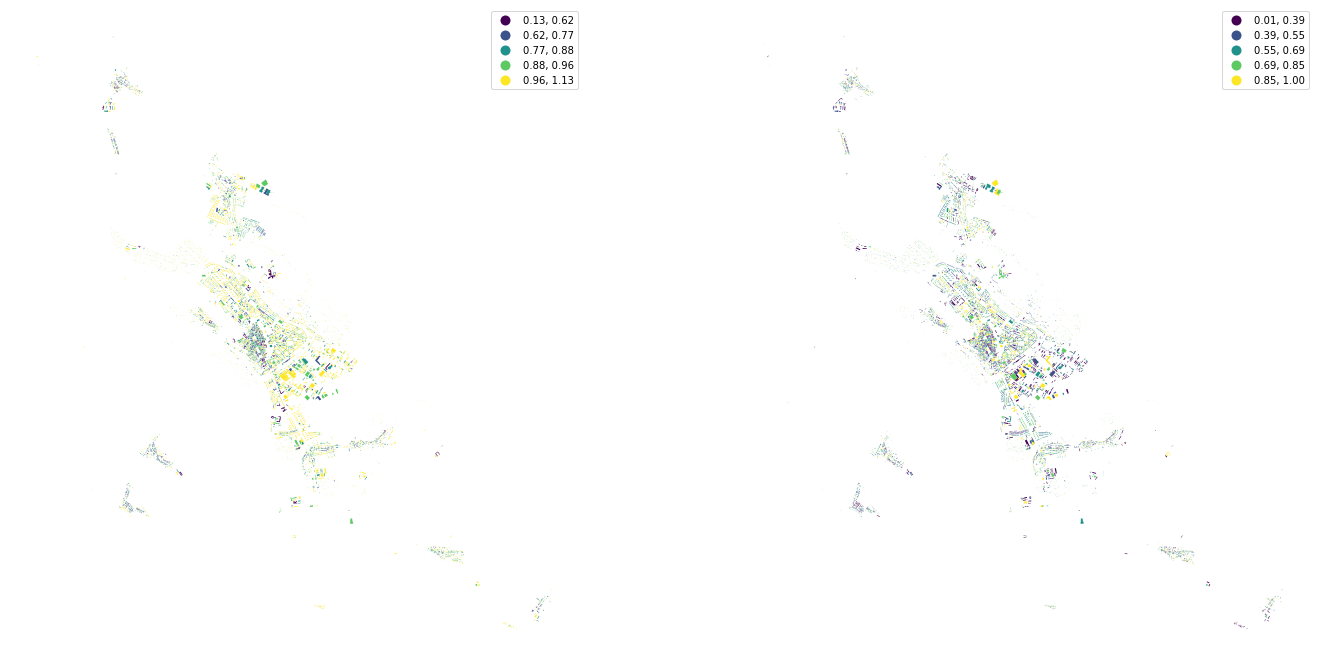
[19]:
fig, ax = plt.subplots(1, 2, figsize=(24, 12))
tessellation.plot("convexity", ax=ax[0], scheme="natural_breaks", legend=True)
streets.plot("linearity", ax=ax[1], scheme="natural_breaks", legend=True)
ax[0].set_axis_off()
ax[1].set_axis_off()
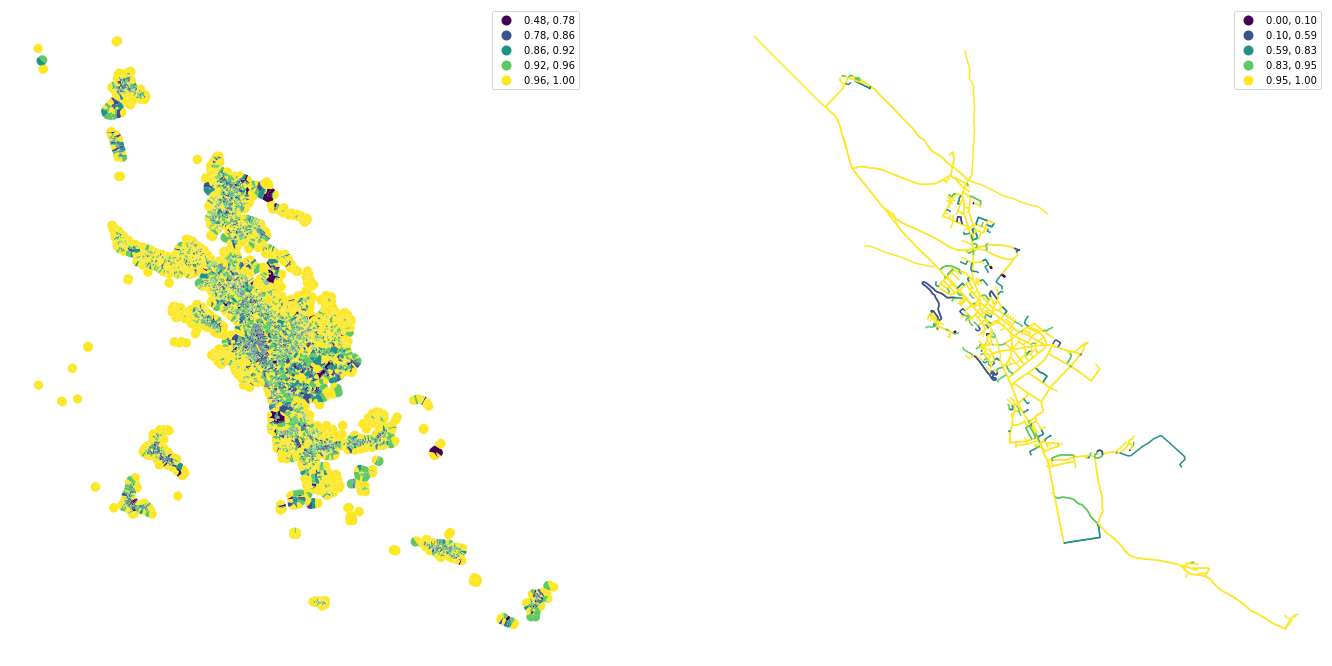
Spatial distribution#
[20]:
buildings["shared_walls"] = momepy.SharedWallsRatio(buildings).series
buildings.plot("shared_walls", figsize=(12, 12), scheme="natural_breaks", legend=True).set_axis_off()
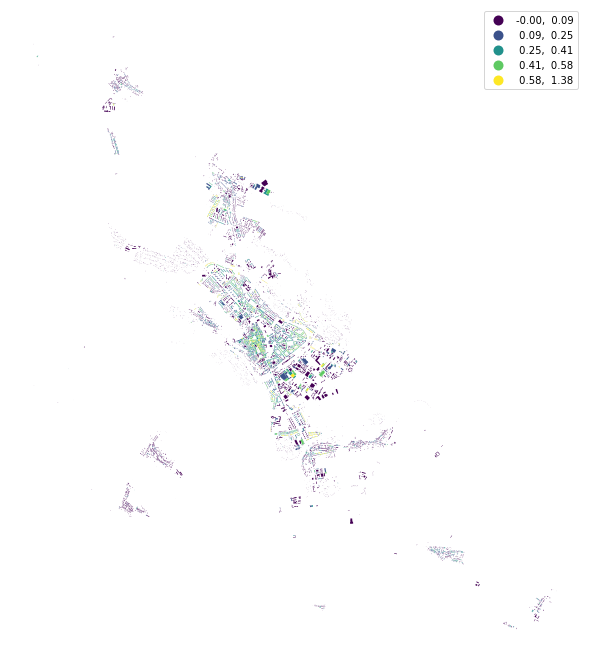
Generate spatial weights matrix using libpysal.
[21]:
queen_1 = libpysal.weights.contiguity.Queen.from_dataframe(tessellation, ids="uID", silence_warnings=True)
/Users/martin/mambaforge/envs/stable/lib/python3.9/site-packages/libpysal/weights/_contW_lists.py:29: ShapelyDeprecationWarning: Iteration over multi-part geometries is deprecated and will be removed in Shapely 2.0. Use the `geoms` property to access the constituent parts of a multi-part geometry.
return list(it.chain(*(list(zip(*shape.coords.xy)) for shape in shape)))
/Users/martin/mambaforge/envs/stable/lib/python3.9/site-packages/libpysal/weights/_contW_lists.py:31: ShapelyDeprecationWarning: Iteration over multi-part geometries is deprecated and will be removed in Shapely 2.0. Use the `geoms` property to access the constituent parts of a multi-part geometry.
return list(it.chain(*(_get_boundary_points(part.boundary) for part in shape)))
[22]:
tessellation["neighbors"] = momepy.Neighbors(tessellation, queen_1, "uID", weighted=True, verbose=False).series
tessellation["covered_area"] = momepy.CoveredArea(tessellation, queen_1, "uID", verbose=False).series
with warnings.catch_warnings():
warnings.simplefilter("ignore")
buildings["neighbor_distance"] = momepy.NeighborDistance(buildings, queen_1, "uID", verbose=False).series
[23]:
fig, ax = plt.subplots(1, 2, figsize=(24, 12))
buildings.plot("neighbor_distance", ax=ax[0], scheme="natural_breaks", legend=True)
tessellation.plot("covered_area", ax=ax[1], scheme="natural_breaks", legend=True)
ax[0].set_axis_off()
ax[1].set_axis_off()

[24]:
queen_3 = momepy.sw_high(k=3, weights=queen_1)
buildings_q1 = libpysal.weights.contiguity.Queen.from_dataframe(buildings, silence_warnings=True)
buildings['interbuilding_distance'] = momepy.MeanInterbuildingDistance(buildings, queen_1, 'uID', queen_3, verbose=False).series
buildings['adjacency'] = momepy.BuildingAdjacency(buildings, queen_3, 'uID', buildings_q1, verbose=False).series
/Users/martin/mambaforge/envs/stable/lib/python3.9/site-packages/libpysal/weights/_contW_lists.py:29: ShapelyDeprecationWarning: Iteration over multi-part geometries is deprecated and will be removed in Shapely 2.0. Use the `geoms` property to access the constituent parts of a multi-part geometry.
return list(it.chain(*(list(zip(*shape.coords.xy)) for shape in shape)))
[25]:
fig, ax = plt.subplots(1, 2, figsize=(24, 12))
buildings.plot("interbuilding_distance", ax=ax[0], scheme="natural_breaks", legend=True)
buildings.plot("adjacency", ax=ax[1], scheme="natural_breaks", legend=True)
ax[0].set_axis_off()
ax[1].set_axis_off()
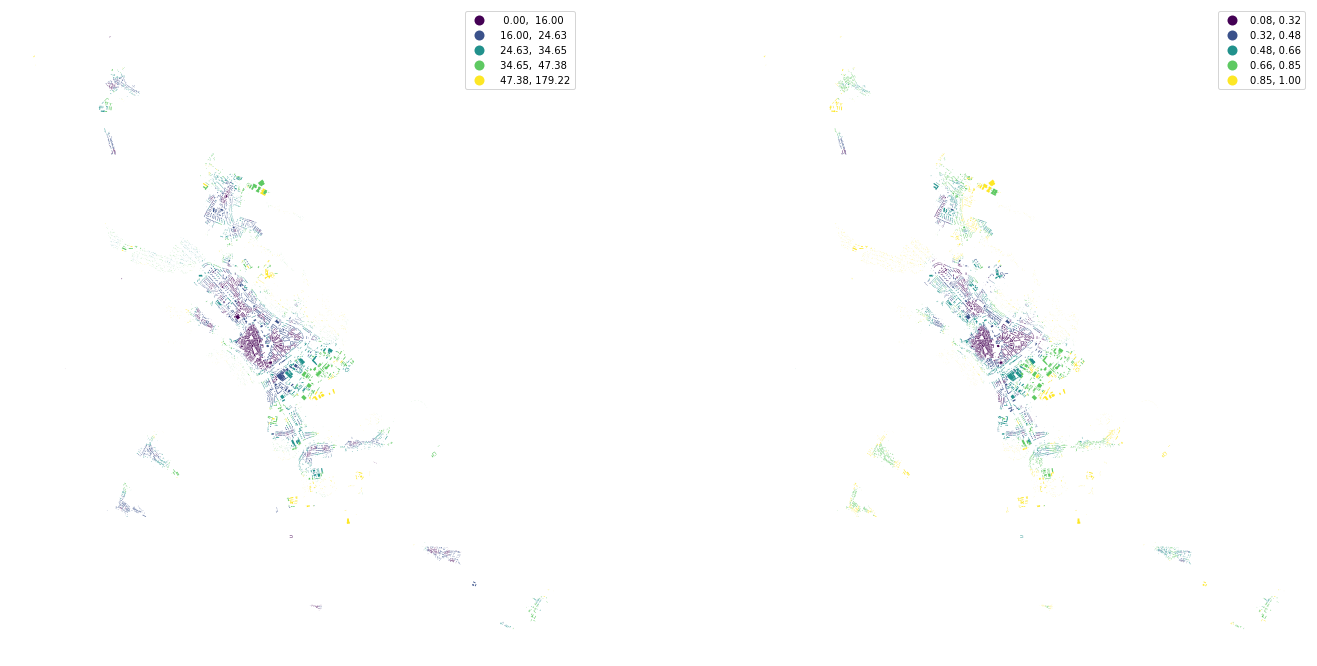
[26]:
profile = momepy.StreetProfile(streets, buildings)
streets["width"] = profile.w
streets["width_deviation"] = profile.wd
streets["openness"] = profile.o
/Users/martin/mambaforge/envs/stable/lib/python3.9/site-packages/numpy/lib/nanfunctions.py:1670: RuntimeWarning: Degrees of freedom <= 0 for slice.
var = nanvar(a, axis=axis, dtype=dtype, out=out, ddof=ddof,
/Users/martin/mambaforge/envs/stable/lib/python3.9/site-packages/momepy/dimension.py:641: RuntimeWarning: invalid value encountered in long_scalars
openness.append(np.isnan(s).sum() / (f).sum())
[27]:
fig, ax = plt.subplots(1, 3, figsize=(24, 12))
streets.plot("width", ax=ax[0], scheme="natural_breaks", legend=True)
streets.plot("width_deviation", ax=ax[1], scheme="natural_breaks", legend=True)
streets.plot("openness", ax=ax[2], scheme="natural_breaks", legend=True)
ax[0].set_axis_off()
ax[1].set_axis_off()
ax[2].set_axis_off()

Intensity#
[28]:
tessellation['car'] = momepy.AreaRatio(tessellation, buildings, 'area', 'area', 'uID').series
tessellation.plot("car", figsize=(12, 12), vmin=0, vmax=1, legend=True).set_axis_off()
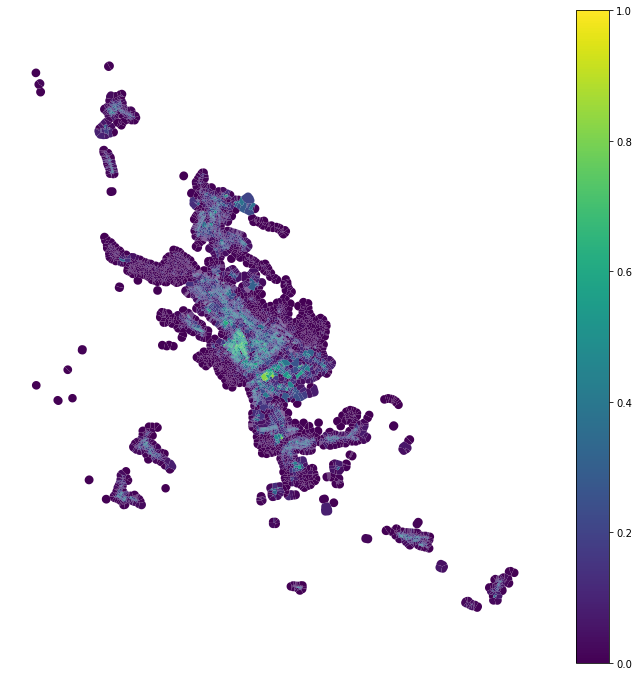
Connectivity#
[29]:
graph = momepy.gdf_to_nx(streets)
graph = momepy.node_degree(graph)
graph = momepy.closeness_centrality(graph, radius=400, distance="mm_len")
graph = momepy.meshedness(graph, radius=400, distance="mm_len")
nodes, streets = momepy.nx_to_gdf(graph)
100%|███████████████████████████████████████████████████████████████████████████████████████████████████████| 756/756 [00:00<00:00, 2081.71it/s]
100%|███████████████████████████████████████████████████████████████████████████████████████████████████████| 756/756 [00:00<00:00, 2234.40it/s]
[30]:
fig, ax = plt.subplots(1, 3, figsize=(24, 12))
nodes.plot("degree", ax=ax[0], scheme="natural_breaks", legend=True, markersize=1)
nodes.plot("closeness", ax=ax[1], scheme="natural_breaks", legend=True, markersize=1, legend_kwds={"fmt": "{:.6f}"})
nodes.plot("meshedness", ax=ax[2], scheme="natural_breaks", legend=True, markersize=1)
ax[0].set_axis_off()
ax[1].set_axis_off()
ax[2].set_axis_off()

[31]:
buildings["nodeID"] = momepy.get_node_id(buildings, nodes, streets, "nodeID", "nID")
100%|███████████████████████████████████████████████████████████████████████████████████████████████████| 12127/12127 [00:01<00:00, 7006.72it/s]
Link all data together (to tessellation cells or buildings).
[32]:
tessellation.head()
[32]:
| uID | geometry | nID | area | convexity | neighbors | covered_area | car | |
|---|---|---|---|---|---|---|---|---|
| 0 | 5453 | POLYGON ((-637358.313 -1200006.277, -637357.92... | 624.0 | 27736.670898 | 0.995293 | 0.003108 | 41793.250296 | 0.007476 |
| 1 | 5418 | POLYGON ((-636871.053 -1199819.853, -636871.45... | 630.0 | 19855.193192 | 0.942935 | 0.005466 | 56679.209969 | 0.022276 |
| 2 | 10635 | POLYGON ((-637462.192 -1199942.387, -637450.89... | 624.0 | 5980.537480 | 0.900015 | 0.006719 | 23484.755027 | 0.066270 |
| 3 | 5452 | POLYGON ((-636574.691 -1199444.622, -636572.80... | 1608.0 | 18362.214059 | 0.988620 | 0.003802 | 42309.584227 | 0.005690 |
| 4 | 10641 | POLYGON ((-637599.665 -1199909.097, -637595.79... | 624.0 | 6221.647571 | 0.829355 | 0.010157 | 43342.518118 | 0.049808 |
[33]:
merged = tessellation.merge(buildings.drop(columns=['nID', 'geometry']), on='uID')
merged = merged.merge(streets.drop(columns='geometry'), on='nID', how='left')
merged = merged.merge(nodes.drop(columns='geometry'), on='nodeID', how='left')
[34]:
merged.columns
[34]:
Index(['uID', 'geometry', 'nID', 'area_x', 'convexity', 'neighbors',
'covered_area', 'car', 'area_y', 'eri', 'elongation', 'shared_walls',
'neighbor_distance', 'interbuilding_distance', 'adjacency', 'nodeID',
'length', 'linearity', 'width', 'width_deviation', 'openness', 'mm_len',
'node_start', 'node_end', 'degree', 'closeness', 'meshedness'],
dtype='object')
Understanding the context#
Measure first, second and third quartile of distribution of values within an area around each building.
[35]:
percentiles = []
for column in merged.columns.drop(["uID", "nodeID", "nID", 'mm_len', 'node_start', 'node_end', "geometry"]):
perc = momepy.Percentiles(merged, column, queen_3, "uID", verbose=False).frame
perc.columns = [f"{column}_" + str(x) for x in perc.columns]
percentiles.append(perc)
/Users/martin/mambaforge/envs/stable/lib/python3.9/site-packages/numpy/lib/nanfunctions.py:1374: RuntimeWarning: All-NaN slice encountered
r, k = function_base._ureduce(
/Users/martin/mambaforge/envs/stable/lib/python3.9/site-packages/numpy/lib/nanfunctions.py:1374: RuntimeWarning: All-NaN slice encountered
r, k = function_base._ureduce(
/Users/martin/mambaforge/envs/stable/lib/python3.9/site-packages/numpy/lib/nanfunctions.py:1374: RuntimeWarning: All-NaN slice encountered
r, k = function_base._ureduce(
/Users/martin/mambaforge/envs/stable/lib/python3.9/site-packages/numpy/lib/nanfunctions.py:1374: RuntimeWarning: All-NaN slice encountered
r, k = function_base._ureduce(
/Users/martin/mambaforge/envs/stable/lib/python3.9/site-packages/numpy/lib/nanfunctions.py:1374: RuntimeWarning: All-NaN slice encountered
r, k = function_base._ureduce(
/Users/martin/mambaforge/envs/stable/lib/python3.9/site-packages/numpy/lib/nanfunctions.py:1374: RuntimeWarning: All-NaN slice encountered
r, k = function_base._ureduce(
/Users/martin/mambaforge/envs/stable/lib/python3.9/site-packages/numpy/lib/nanfunctions.py:1374: RuntimeWarning: All-NaN slice encountered
r, k = function_base._ureduce(
/Users/martin/mambaforge/envs/stable/lib/python3.9/site-packages/numpy/lib/nanfunctions.py:1374: RuntimeWarning: All-NaN slice encountered
r, k = function_base._ureduce(
/Users/martin/mambaforge/envs/stable/lib/python3.9/site-packages/numpy/lib/nanfunctions.py:1374: RuntimeWarning: All-NaN slice encountered
r, k = function_base._ureduce(
/Users/martin/mambaforge/envs/stable/lib/python3.9/site-packages/numpy/lib/nanfunctions.py:1374: RuntimeWarning: All-NaN slice encountered
r, k = function_base._ureduce(
/Users/martin/mambaforge/envs/stable/lib/python3.9/site-packages/numpy/lib/nanfunctions.py:1374: RuntimeWarning: All-NaN slice encountered
r, k = function_base._ureduce(
[36]:
percentiles_joined = pandas.concat(percentiles, axis=1)
percentiles_joined.head()
[36]:
| area_x_25 | area_x_50 | area_x_75 | convexity_25 | convexity_50 | convexity_75 | neighbors_25 | neighbors_50 | neighbors_75 | covered_area_25 | ... | openness_75 | degree_25 | degree_50 | degree_75 | closeness_25 | closeness_50 | closeness_75 | meshedness_25 | meshedness_50 | meshedness_75 | |
|---|---|---|---|---|---|---|---|---|---|---|---|---|---|---|---|---|---|---|---|---|---|
| 0 | 7151.505440 | 8460.534526 | 9102.552267 | 0.874500 | 0.888902 | 0.929755 | 0.006852 | 0.007068 | 0.007307 | 38509.340860 | ... | 0.952261 | 6.0 | 6.0 | 6.0 | 0.000064 | 0.000064 | 0.000064 | 0.866667 | 0.866667 | 0.866667 |
| 1 | 2635.809199 | 3979.104339 | 7912.110750 | 0.906751 | 0.943435 | 0.980033 | 0.012226 | 0.021552 | 0.027465 | 34791.666675 | ... | 1.000000 | 4.0 | 6.0 | 6.0 | 0.000067 | 0.000067 | 0.000075 | 0.764706 | 0.866667 | 1.000000 |
| 2 | 4869.281367 | 6119.443335 | 9102.552267 | 0.874500 | 0.947803 | 0.971754 | 0.007068 | 0.008105 | 0.009836 | 28474.090836 | ... | 0.952261 | 6.0 | 6.0 | 6.0 | 0.000064 | 0.000064 | 0.000064 | 0.866667 | 0.866667 | 0.866667 |
| 3 | 774.500023 | 2527.511720 | 9756.635411 | 0.841715 | 0.946898 | 0.979633 | 0.012229 | 0.026525 | 0.032112 | 10886.683093 | ... | 0.611111 | 1.0 | 4.0 | 7.0 | 0.000044 | 0.000056 | 0.000074 | 0.666667 | 0.764706 | 0.764706 |
| 4 | 5615.435876 | 6119.443335 | 8460.534526 | 0.888902 | 0.947803 | 0.971754 | 0.007598 | 0.008616 | 0.009836 | 27790.702394 | ... | 0.952261 | 6.0 | 6.0 | 6.0 | 0.000064 | 0.000064 | 0.000064 | 0.866667 | 0.866667 | 0.866667 |
5 rows × 60 columns
See the difference between original convexity and spatially lagged one.
[37]:
fig, ax = plt.subplots(1, 2, figsize=(24, 12))
tessellation.plot("convexity", ax=ax[0], scheme="natural_breaks", legend=True)
merged.plot(percentiles_joined['convexity_50'].values, ax=ax[1], scheme="natural_breaks", legend=True)
ax[0].set_axis_off()
ax[1].set_axis_off()

Clustering#
Now we can use obtained values within a cluster analysis that should detect types of urban structure.
Standardize values before clustering.
[38]:
standardized = (percentiles_joined - percentiles_joined.mean()) / percentiles_joined.std()
standardized.head()
[38]:
| area_x_25 | area_x_50 | area_x_75 | convexity_25 | convexity_50 | convexity_75 | neighbors_25 | neighbors_50 | neighbors_75 | covered_area_25 | ... | openness_75 | degree_25 | degree_50 | degree_75 | closeness_25 | closeness_50 | closeness_75 | meshedness_25 | meshedness_50 | meshedness_75 | |
|---|---|---|---|---|---|---|---|---|---|---|---|---|---|---|---|---|---|---|---|---|---|
| 0 | 3.907232 | 3.744142 | 2.446186 | -1.143424 | -2.938231 | -3.733482 | -2.119526 | -2.288624 | -2.285125 | 4.403142 | ... | 1.545997 | 1.162460 | 0.754077 | 0.390482 | -0.160493 | -0.376773 | -0.569981 | 1.356558 | 1.186797 | 0.666247 |
| 1 | 1.192925 | 1.449191 | 2.020484 | -0.173765 | -0.333045 | 0.415801 | -1.727120 | -1.477709 | -1.462961 | 3.880431 | ... | 1.786410 | 0.123991 | 0.754077 | 0.390482 | -0.113155 | -0.333712 | -0.407101 | 0.962200 | 1.186797 | 1.063455 |
| 2 | 2.535427 | 2.545264 | 2.446186 | -1.143424 | -0.124355 | -0.267492 | -2.103782 | -2.230578 | -2.181994 | 2.992171 | ... | 1.545997 | 1.162460 | 0.754077 | 0.390482 | -0.160493 | -0.376773 | -0.569981 | 1.356558 | 1.186797 | 0.666247 |
| 3 | 0.074124 | 0.705828 | 2.680086 | -2.129171 | -0.167582 | 0.382748 | -1.726925 | -1.199249 | -1.273425 | 0.519354 | ... | -0.172044 | -1.433713 | -0.363338 | 1.010911 | -0.509939 | -0.498467 | -0.423321 | 0.583010 | 0.777269 | 0.362500 |
| 4 | 2.983927 | 2.545264 | 2.216600 | -0.710405 | -0.124355 | -0.267492 | -2.065064 | -2.201966 | -2.181994 | 2.896085 | ... | 1.545997 | 1.162460 | 0.754077 | 0.390482 | -0.160493 | -0.376773 | -0.569981 | 1.356558 | 1.186797 | 0.666247 |
5 rows × 60 columns
How many clusters?#
To determine how many clusters we should aim for, we can use a little package called clustergram. See its documentation for details.
[39]:
cgram = Clustergram(range(1, 12), n_init=10, random_state=42)
cgram.fit(standardized.fillna(0))
show(cgram.bokeh())
K=1 skipped. Mean computed from data directly.
K=2 fitted in 0.09209084510803223 seconds.
K=3 fitted in 0.17666196823120117 seconds.
K=4 fitted in 0.1387166976928711 seconds.
K=5 fitted in 0.1958770751953125 seconds.
K=6 fitted in 0.2466108798980713 seconds.
K=7 fitted in 0.25217103958129883 seconds.
K=8 fitted in 0.23486900329589844 seconds.
K=9 fitted in 0.2962191104888916 seconds.
K=10 fitted in 0.39074087142944336 seconds.
K=11 fitted in 0.3091151714324951 seconds.
/Users/martin/mambaforge/envs/stable/lib/python3.9/site-packages/bokeh/io/notebook.py:487: DeprecationWarning: The `source` parameter emit a deprecation warning since IPython 8.0, it had no effects for a long time and will be removed in future versions.
publish_display_data(data, metadata, source, transient=transient, **kwargs)
Clustegram gives us also the final labels. (Normally, you would run the final clustering on much larger number of initialisations.)
[40]:
cgram.labels.head()
[40]:
| 1 | 2 | 3 | 4 | 5 | 6 | 7 | 8 | 9 | 10 | 11 | |
|---|---|---|---|---|---|---|---|---|---|---|---|
| 0 | 0 | 1 | 2 | 3 | 3 | 1 | 5 | 0 | 6 | 6 | 5 |
| 1 | 0 | 1 | 2 | 3 | 3 | 1 | 5 | 0 | 6 | 6 | 5 |
| 2 | 0 | 1 | 2 | 3 | 3 | 1 | 5 | 0 | 6 | 6 | 5 |
| 3 | 0 | 1 | 1 | 1 | 2 | 2 | 1 | 4 | 2 | 2 | 10 |
| 4 | 0 | 1 | 2 | 3 | 3 | 1 | 5 | 0 | 6 | 6 | 5 |
[41]:
merged["cluster"] = cgram.labels[8].values
urban_types = buildings[["geometry", "uID"]].merge(merged[["uID", "cluster"]], on="uID")
urban_types.plot("cluster", categorical=True, figsize=(16, 16), legend=True).set_axis_off()
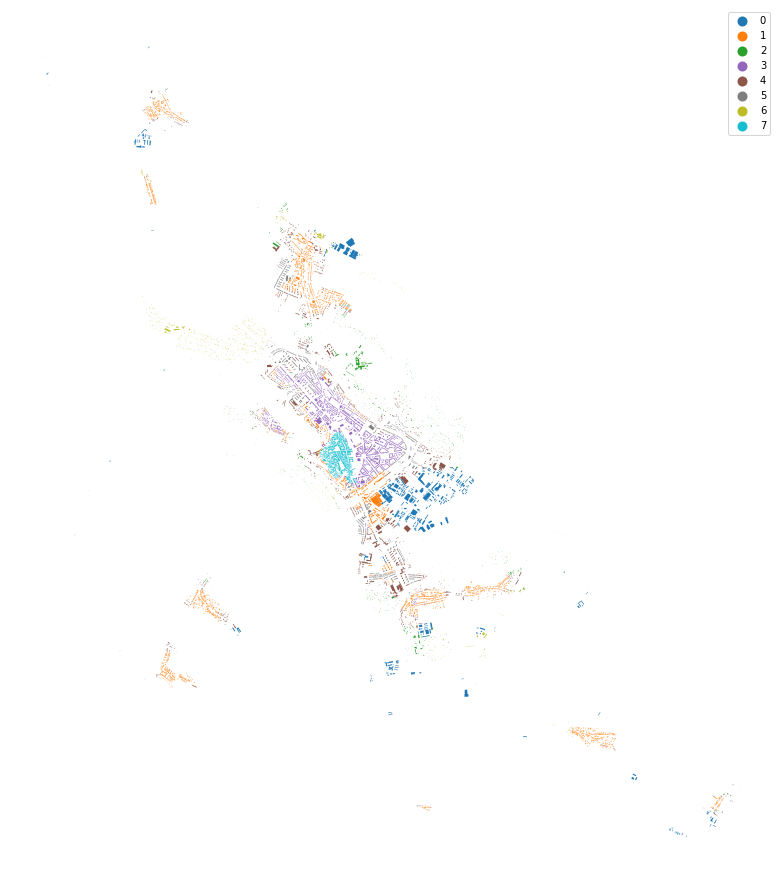
[46]:
ax = urban_types.plot("cluster", categorical=True, figsize=(16, 16), legend=True)
ax.set_xlim(-645000, -641000)
ax.set_ylim(-1195500, -1191000)
ax.set_axis_off()
